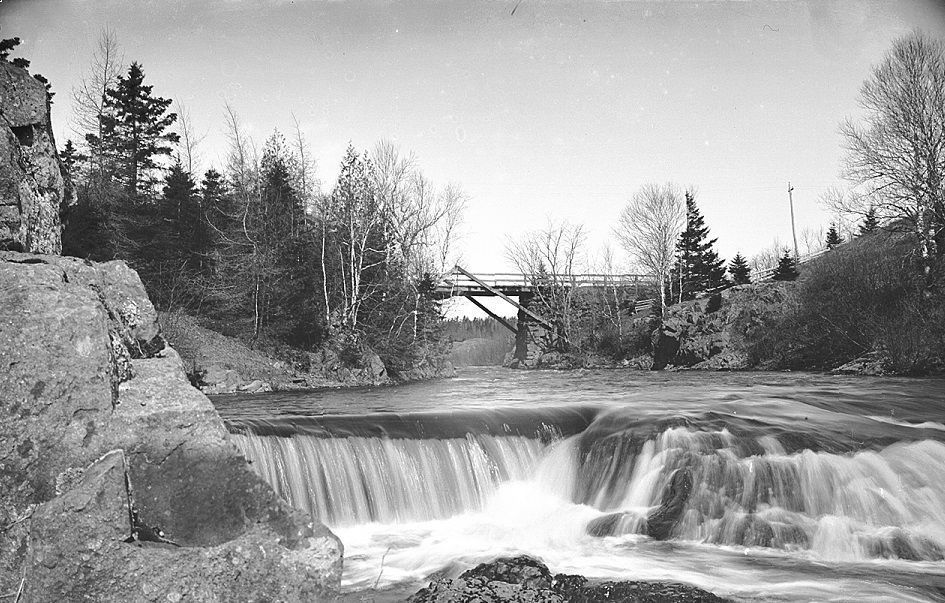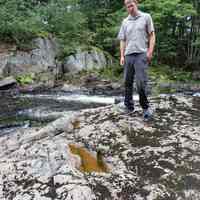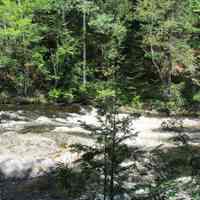Audubon Dam Site, Dennys River, Dennysville, Maine
Ambrotype
John James Audubon described the effect of the temporary lumbermen's dam across the Dennys River in his essay "The Force of the Waters," reprinted here from "Audubon and His Journals," edited by his granddaughter, Maria Audubon, in a Dover reprint edition: At the upper extremity of Dennysville, which is itself a pretty village, are the saw-mills and ponds of the hospitable Judge Lincoln and other persons. The creek that conveys the logs to these ponds, and which bears the name of the village, is interrupted in its course by many rapids and narrow embanked gorges. One of the latter is situated about half a mile above the mill-dams, and is so rocky and rugged in its bottom and sides as to preclude the possibility of the trees passing along it at low water, while, as I conceived, it would have given no slight labor to an army of woodsmen or millers to move the thousands of large logs that had accumulated in it. They lay piled in confused heaps to a great height along an extent of several hundred yards, and were in some places so close as to have formed a kind of dam. Above the gorge there is a large natural reservoir, in which the head-waters of the creek settle, while only a small portion of them ripples through the gorge below, during the later weeks of summer and in early autumn, when the streams are at their lowest. At the neck of this basin the lumberers raised a temporary barrier with the refuse of their sawn logs. The boards were planted nearly upright, and supported at their tops by a strong tree extending from side to side of the creek, which might there be about forty feet in breadth. It was prevented from giving way under pressure of the rising waters by having strong abutments of wood laid against its centre, while the ends of these abutments were secured by wedges, which could be knocked off when necessary. The temporary dam was now finished. Little or no water escaped through the barrier, and that in the creek above it rose in the course of three weeks to its top, which was about ten feet high, forming a sheet that extended upwards fully a mile from the dam. My family was invited early one morning to go and witness the extraordinary effect which would be produced by the breaking down of the barrier, and we all accompanied the lumberers to the place. Two of the men, on reaching it, threw off their jackets, tied handkerchiefs round their heads, and fastened to their bodies a long rope, the end of which was held by three or four others, who stood ready to drag their companions ashore, in case of danger or accident. The two operators, each bearing an axe, walked along the abutments, and at a given signal knocked out the wedges. A second blow from each sent off the abutments themselves, and the men, leaping with extreme dexterity from one cross log to another, sprung to the shore with almost the quickness of thought Scarcely had they effected their escape from the frightful peril which threatened them, when the mass of waters burst forth with a horrible uproar. All eyes were bent towards the huge heaps of logs in the gorge below. The tumultuous burst of the waters instantly swept away every object that opposed their progress, and rushed in foaming waves among the timbers that everywhere blocked up the pas-sage. Presently a slow, heavy motion was perceived in the mass of logs; one might have imagined that some mighty monster lay convulsively writhing beneath them, struggling with a fearful energy to extricate himself from the crushing weight. As the waters rose, this movement increased; the mass of timber extended in all directions, appearing to become more and more entangled each moment ; the logs bounced against each other, thrusting aside, demersing, or raising into the air those with which they came in contact; it seemed as if they were waging a war of destruction, such as ancient authors describe the efforts of the Titans, the foamings of whose wrath might to the eye of the painter have been represented by the angry curlings of the waters, while the tremulous and rapid motions of the logs, which at times reared themselves almost perpendicularly, might by the poet have been taken for the shakings of the confounded and discomfited giants. Now the rushing element filled up the gorge to its brim. The logs, once under way, rolled, reared, tossed, and tum-bled amid the foam, as they were carried along. Many of the smaller trees broke across, from others great splinters were sent up, and all were in some degree seamed and scarred. Then in tumultuous majesty swept along the mingled wreck, the current being now increased to such a pitch that the logs, as they were dashed against the rocky shores, resounded like the report of distant artillery, or the angry rumblings of the thunder. Onward it rolls, the emblem of wreck and ruin, destruction and chaotic strife. It seemed to me as if I witnessed the rout of a vast army, surprised, overwhelmed, and overthrown. The roar of the cannon, the groans of the dying, and the shouts of the avengers were thundering through my brain, and amid the frightful confusion of the scene, there came over my spirit a melancholy feeling, which had not entirely vanished at the end of many days. In a few hours almost all the timber that had lain heaped in the rocky gorge, was floating in the great pond of the millers; and as we walked homeward we talked of the Force of the Waters.
Dennys River Historic PhotographsJohn P. Sheahan CollectionPhotos for Map
circa 1880 - circa 1890
Video link to "The Force of the Waters: Audubon's Dam Site on the Dennys River."Audubon Dam site on the Dennys RiverThe Lincoln Finch in Audubon's Ornithological Biography"Spotted Grouse" painted by John James Audubon in Dennysville in 1832
Cataloging Note
Original glass negatives of this image are housed at the Tides Museum and Institute of Art in Eastport, Maine.




